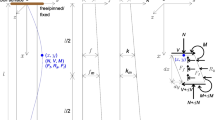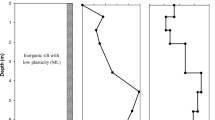Abstract
The purpose of this paper is to investigate the influence of Soil-Structure Interaction (SSI) and Pile-Soil-Structure Interaction (PSSI) on vibration control effect. Assuming the ground as an isotropic elastic half space and the soil around the foundation as a horizontal and rotational spring-dashpot system, a SSI model for buildings with rigid shallow foundations is established. Based on Penzien model, a PSSI model for structures with pile-foundations is also set up. Then, after the motion and control equations of the SSI system and PSSI system are derived, the influences of SSI and PSSI on vibration control are investigated. Important parameters of soil and structures are studied. Numerical results show that the SSI and PSSI have an obvious influence on the control effect of structures. Parameters such as shear-wave velocity, embedded depth of soil and stiffness of superstructure and pile, play a significant role in vibration control. The influences of SSI and PSSI mainly depend on characteristics of the upper soil layer, hence, the SSI influence on buildings with rigid foundations is more obvious than that of PSSI on buildings with pile foundations.
Similar content being viewed by others
References
Aldemir, U. and Bakioglu, M. (2001). “Active structural control based on the prediction and degree of stability.” Journal of Sound and Vibration, Vol. 247, No. 4, pp. 61–76.
Alli, H. and Singh, T. (2000). “On the feedback control of the wave equation.” Journal of Sound and Vibration, Vol. 234, No. 4, pp. 625–640.
Cai, G. and Huang, J. (2002). “Optimal control method with time delay in control.” Journal of Sound and Vibration, Vol. 251, No. 3, pp. 383–394.
Chung, L. L., Lin, C. C., and Chu, S. Y. (1993). “Optimal direct output feedback of structural control.” Journal of Engineering Mechanics, ASCE, Vol. 119, No. 11, pp. 57–73.
Kerbera, F., Hurlebausb, S., and Beadlec, B. M. (2007). “Control concepts for an active vibration isolation system.” Mechanical Systems and Signal Processing. Vol. 21, No. 8, pp. 3042–3059.
Kobori, T., Koshika, N., Yamada, K., and Ikeda, Y. (1991). “Seismicresponse-controlled structure with active mass driver system.” Part 2: Verification. Earthquake Engineering and Structural Dynamics, Vol. 20, No. 2, pp. 51–66.
Lin, C. C., Chang, C. C., and Wang, J. F. (2009). “Active control of irregular buildings considering soil-structure interaction effects.” Soil Dynamics and Earthquake Engineering, Vol. 29, No. 3, pp. 1–11.
Lou, M. L., Wang, W. J., and Ma, H. C. (2001). “Study on soil-pilestructure interaction system by shaking table model test.” Journal of Tongji University, Vol. 29, No. 7, pp. 132–139.
Lu, L. T., Chiang, W. L., and Tang. J. P. (1998). “LQG/LTR control methodology in active structural control.” Journal of Engineering Mechanics, ASCE, Vol. 124, No. 4, pp. 46–54.
Luco, J. E. (1998). “A simple model for structural control including soil-structure interaction effects.” Earthquake Engng. Struct. Dyn., Vol. 27, No. 3, pp. 225–242.
Maki, T., Maekawa, K., and Mutsuyoshi, H. (2006). “RC pile-soil interaction analysis using a 3D-finite element method with fibre theory-based beam elements.” Earthquake Engineering & Structural Dynamics, Vol. 35, No. 13, pp. 1587–1607.
Park, K. S., Jung, H. J., and Lee, I. W. (2003). “Hybrid control strategy for seismic protection of a benchmark cable-stayed bridge.” Engineering Structures, Vol. 25, No. 4, pp. 405–417.
Richart, F. E. and Whitman, R. V. (1967). “Comparison of footing vibration tests with theory.” Journal of Soil Mechanics & Foundations Div.ASCE, Vol. 93, No. 6, pp. 143–168.
Smith, H. A. and Wu, W. H. (1997). “Effective optimal structural control of soil-structure interaction systems.” Earthquake Engineering and Structural Dynamics, Vol. 26, No. 5, pp. 549–570.
Smith, H. D., Wu, W. H., and Borja, R. I. (1994). “Structural control considering soil-structure interaction effects.” Earthquake Engng. Struct. Dyn., Vol. 23, No. 6, pp. 609–626.
Soong, T. T. and Spencer, J. B. (2000). “Active, semi-active and hybrid control of structures.” Bulletin of the New Zealand National Society for Earthquake Engineering, Vol. 33, No. 1, pp. 387–402.
Wang, A. P. and Lin, Y. H. (2007). “Vibration control of a tall building subjected to earthquake excitation.” Journal of Sound and Vibration, Vol. 299, Nos. 4–5, pp. 757–773.
Wang, H. D. and Shang, S. P. (2006). “Computational research on vertical dynamic response of single-pile considering pile-soil interaction during passage of Rayleigh waves.” Engineering Mechanics, Vol. 6, No. 8, pp. 72–75.
Wei, X., Fan, L. C., and Wang, J. J. (2002). “Shake table test on soilpile-structure interaction.” Civil Engineering Journal, Vol. 35, No. 4, pp. 54–60.
Wong, H. L. and Luco, J. E. (1991). “Structural control including soil-structure interaction effects.” J. Engng. Mech. ASCE, Vol. 1, No. 10, pp. 2237–2250.
Wu, W. H. and Smith, H. A. (1995). “Comparison of SSI effects on externally and internally controlled systems.” Smart Mater. Struct., Vol. 4, No. 4, pp. 158–168.
Wu, J. C. and Yang, J. N. (2000). “LQG control of lateral-torsional motion of Nanjing TV transmission tower.” Earthquake Engineering and Structural Dynamics, Vol. 29, No. 8, pp. 11–30.
Zhang, G., Pan, D. Z., and Chen, J. X. (2006). “Analysis of pile-soil interaction by computer simulation.” Experimental Mechanics in Nano and Biotechnology, Vol. 326, No. 1, pp. 1531–1534.
Zou, L. H. and Zhao, R. D. (2005). “Analysis of the random responses to earthquake of the subsoil-base-interaction isolated system.” Journal of Computational Mechanics, Vol. 22, No. 6, pp. 72–76.
Zou, L. H., Zhao, R. D., and Zhao, J. C. (2004). “Analysis of the response to earthquake of the pile-soil-isolated structure interaction.” Journal of Geotechnical Engineering, Vol. 26, No. 6, pp. 782–786.
Author information
Authors and Affiliations
Corresponding author
Rights and permissions
About this article
Cite this article
Zou, L., Fang, L., Huang, K. et al. Vibration control of soil-structure systems and Pile-Soil-Structure systems. KSCE J Civ Eng 16, 794–802 (2012). https://doi.org/10.1007/s12205-012-1358-2
Received:
Revised:
Accepted:
Published:
Issue Date:
DOI: https://doi.org/10.1007/s12205-012-1358-2




